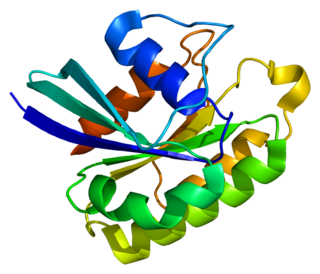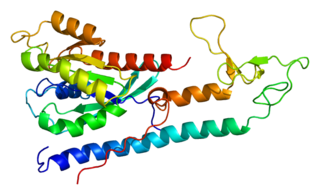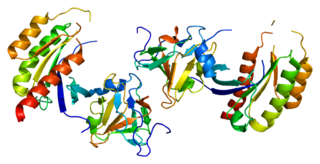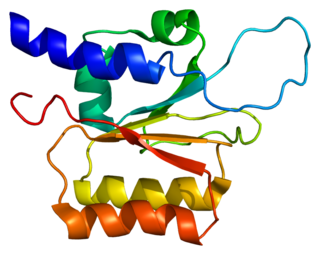Ras-related protein Rab-1A is a protein that in humans is encoded by the RAB1A gene. [5] [6]
Ras-related protein Rab-1A is a protein that in humans is encoded by the RAB1A gene. [5] [6]
RAB1A has been shown to interact with:
The Rab family of proteins is a member of the Ras superfamily of small G proteins. Approximately 70 types of Rabs have now been identified in humans. Rab proteins generally possess a GTPase fold, which consists of a six-stranded beta sheet which is flanked by five alpha helices. Rab GTPases regulate many steps of membrane trafficking, including vesicle formation, vesicle movement along actin and tubulin networks, and membrane fusion. These processes make up the route through which cell surface proteins are trafficked from the Golgi to the plasma membrane and are recycled. Surface protein recycling returns proteins to the surface whose function involves carrying another protein or substance inside the cell, such as the transferrin receptor, or serves as a means of regulating the number of a certain type of protein molecules on the surface.

Ras-related protein Rab-5A is a protein that in humans is encoded by the RAB5A gene.

Ras-related protein Rab-6A is a protein that in humans is encoded by the RAB6A gene located in the eleventh chromosome. Its main function is the regulation of protein transport from the Golgi complex to the endoplasmic reticulum and the exocytosis along with the microtubules.

Coatomer subunit beta is a protein that in humans is encoded by the COPB1 gene.

Golgin subfamily A member 2, also known as 130 kDa cis-Golgi matrix protein 1 (GM130) is a protein that in humans is encoded by the GOLGA2 gene.

Ras-related protein Rab-3A is a protein that in humans is encoded by the RAB3A gene. It is involved in calcium-triggered exocytosis in neurons.

General vesicular transport factor p115 is a protein that in humans is encoded by the USO1 gene.

Ras-related protein Rab-8A is a protein that in humans is encoded by the RAB8A gene.

Syntaxin-5 is a protein that in humans is encoded by the STX5 gene.

Golgi SNAP receptor complex member 1 is a protein that in humans is encoded by the GOSR1 gene.

Ras-related protein Rab-2A is a protein that in humans is encoded by the RAB2A gene.

Golgi reassembly-stacking protein of 55 kDa (GRASP55) also known as golgi reassembly-stacking protein 2 (GORASP2) is a protein that in humans is encoded by the GORASP2 gene. It was identified by its homology with GRASP65 and the protein's amino acid sequence was determined by analysis of a molecular clone of its complementary DNA. The first (N-terminus) 212 amino acid residues of GRASP55 are highly homologous to those of GRASP65, but the remainder of the 454 amino acid residues are highly diverged from GRASP65. The conserved region is known as the GRASP domain, and it is conserved among GRASPs of a wide variety of eukaryotes, but not plants. The C-terminus portion of the molecule is called the SPR domain. GRASP55 is more closely related to homologues in other species, suggesting that GRASP55 is ancestral to GRASP65. GRASP55 is found associated with the medial and trans cisternae of the Golgi apparatus.

Golgin subfamily A member 5 is a protein that in humans is encoded by the GOLGA5 gene.

Golgin-45 is a protein that in humans is encoded by the BLZF1 gene.

GRIP and coiled-coil domain-containing protein 2 is a protein that in humans is encoded by the GCC2 gene.

Sec1 family domain-containing protein 1 is a protein that in humans is encoded by the SCFD1 gene.

Golgi SNAP receptor complex member 2 is a protein that in humans is encoded by the GOSR2 gene.

Ras-related protein Rab-27A is a protein that in humans is encoded by the RAB27A gene.

Giantin or Golgin subfamily B member 1 is a protein that in humans is encoded by the GOLGB1 gene. Giantin is located at the cis-medial rims of the Golgi apparatus and is part of the Golgi matrix that is responsible for membrane trafficking in secretory pathway of proteins. This function is key for proper localisation of proteins at the plasma membrane and outside the cell which is important for cell function that is dependent on for example receptors and the extracellular matrix function. Recent animal model knockout studies of GOLGB1 in mice, rat, and zebrafish have shown that phenotypes are different between species ranging from mild to severe craniofacial defects in the rodent models to just minor size defects in zebrafish. However, in adult zebrafish a tumoral calcinosis-like phenotype was observed, and in humans such phenotype has been linked to defective glycosyltransferase function.

The Golgi matrix is a collection of proteins involved in the structure and function of the Golgi apparatus. The matrix was first isolated in 1994 as an amorphous collection of 12 proteins that remained associated together in the presence of detergent and 150 mM NaCl. Treatment with a protease enzyme removed the matrix, which confirmed the importance of proteins for the matrix structure. Modern freeze etch electron microscopy (EM) clearly shows a mesh connecting Golgi cisternae and associated vesicles. Further support for the existence of a matrix comes from EM images showing that ribosomes are excluded from regions between and near Golgi cisternae.